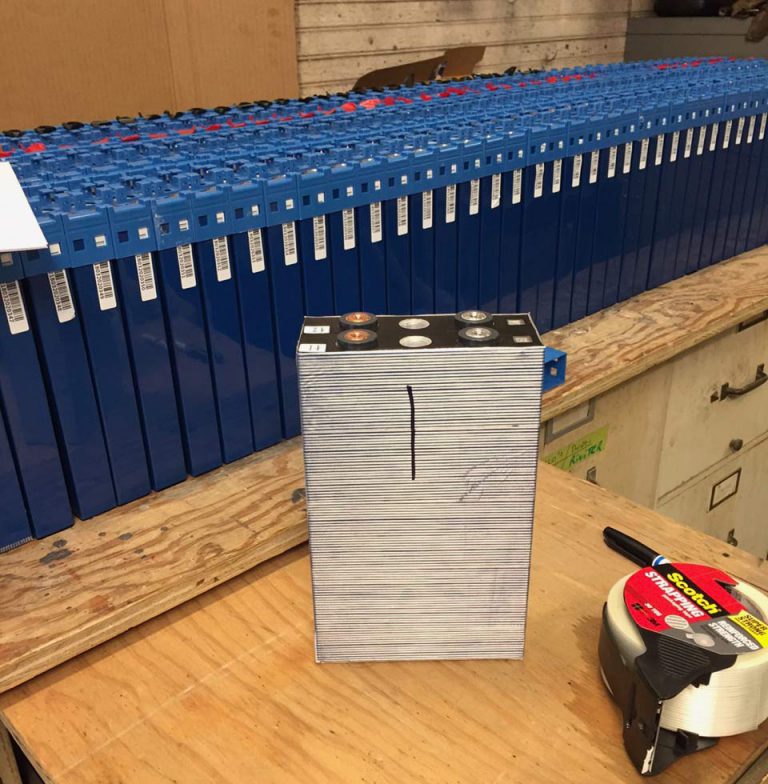One of the great success stories of Seven has been its batteries. In an EV world filled with dire warnings about the hazards of Lithium Ion batteries, our LiFePO4 (lithium iron phosphate) cells made by CALB have been rock solid from the beginning. We’ve:
- welded next to and over them, burning gauges in their plastic cases
- drilled holes through them
- accidently shorted across their terminals with wrenches
- over-charged
- over-discharged
- unknowingly used poorly designed BMS systems
- cut them in half on a chop saw and thrown the remains in a wood burning stove
The most exciting thing that happened was the Allen wrench I accidently shorted across 21 of the cells hooked in series — it disappeared in a sizzling flash…
As a result we’re being a little more careful around high voltage, and we decided that these cells worked a whole lot better without a BMS.
Basically CALB cells just work and because of this and their inherently safe design and chemistry, we believe should be the choice for all home EV builders and industrial applications, say for an electric Skid Steer…A.K.A. a BobCat.
The story of our specific cells is a bit long and clouded in some mystery, including weather the new cells we purchased in 2008 from a reseller were really new when we got them back in early 2009. Many bits and pieces of the story of these cells have been relayed to us since that time, but all we know for sure is that: there were 96 of them, they were blue instead of the expected yellow, they were 100 Amp Hour, they had serial numbers ranging from TS100aha003 thru TS100aha105(making them possibly the first blue cells manufactured for Thunder Sky by Sky Energy which later became CALB), there were no dates on the cells, they appeared to be used based on multiple handwritten numbers on their cases and because voltages ranged between 1.0 to 3.2 volts( 4 cells at 1 Volt, about 30-40 cells ranging 2.5-2.7 Volts, and the rest at 3.1-3.2 volts).
We later heard from one of the previous owners of the US reseller that sold them to us that these cells had been taken out of a RAV4 that they had converted to electric that was having problems with its battery pack…which would explain the voltage variations and confirm the pack was used, and the low voltages would also indicate probably abused.)
Despite the uncertain early life and abuse of these cells and the continued abuse we continued to inflict upon them during the early days of our lithium battery learning curve and lack of good data available for the care and treatment of these cells, we used them for 10 years with an original range of 200+ miles at highway speeds down to 150+ miles when we removed them from Seven this spring and redesigned and built a brand new pack using BRAND NEW CALB 72 Amp hour cells!
As you may know, we took Seven to the 2018 Battery Show in Novi, Michigan this past fall. We showed off the car, gave rides and a presentation on how to increase EV efficiency, with Seven as our proof of concept. While there we met a lot of great people, companies and some old EV friends…like Torsten from Bender, the man and the company that made meeting the ground fault detection requirements of the Automotive X-Prize possible, and the folks at Mitsubishi Power Electronics who the year before had donated their new 7th generation IGBTs for us to try out in Seven (which worked better than expected giving us an overall increase in efficiency of 12% and a power increase to match! We really enjoyed being able to show the performance increase their IGBTs made possible by leaving some rubber in the parking lot at the convention center with some of Mitsubishi’s management in the car.)
While giving one of our many presentations on Seven’s drivetrain and showing off one of the CALB batteries we use in our car, and telling everyone the abuse we had put the batteries through, I was asked by one of the attendees if we always talked about the batteries this way. He picked up the one we had on display and looked it over. I said, “Yes. We love these batteries!” I quickly ran through the list of abuses we had exposed them too and with a huge grin on my face finished with “not only are they a very safe chemistry, they’re idiot-proof.”
He then introduced himself as Keegan Han, CEO of CALB USA Inc.
I immediately second guessed saying the whole “idiot-proof” thing, but it’s true, and I should know; I’m mostly an idiot. But hey, how do you know if something works and is safe unless you try it for yourself? And I’m not going to tell someone else they’re safe and recommend their use unless I’ve not only tried them but tested their limits.
Han said that they definitely wanted to work with us and get us some new cells for Seven. And he did! CALB gave us an incredible deal on 200 brand new (CAM72AHA) cells. We redesigned and installed them in Seven this winter. Our original CALB cells were responsible for much of Seven’s success and, thanks to the new cells, its future achievements! With the new cells installed and one whole charge cycle complete Seven’s new stats are:
- Capacity 46.5 kWh
- Range: 290 miles on a charge (mixed highway and in town semi-aggressive fun driving)
- Charge Time from (empty): 6.75 hours.
- Total vehicle weight:: approx. 3044 lbs (100 lbs heavier)
My daily round trip drive to work is about 60 miles. With the new cells I can now drive to work all week, go to the store, take in a movie and not have to plug in until the weekend; this is just the right range for me. After only one cycle on the batteries I already find myself ignoring the state of charge gauge, knowing I can drive all week and just plug in on Saturday. It’s a good feeling.
A bit on how we installed the cells:
The cells come tested and at about 50% state of charge (SOC) but just in case of anomalies we like to bottom balance the cells, as we did with our old cells to great success. So we hooked up groups of 40 cells in parallel, then took 4 parallel sets and hooked them in series, taking the 12 volt series string and using an inverter, fed the power back into the grid to drain the batteries. After draining all the cells to about 2.9 volts, we drained individual parallel stings on our battery balancer down to about 2.5 volts, allowing them to rebound to about 2.79 volts. Once this process had been performed on all the cells, then the arduous task of hooking all 200 cells in parallel and leave them sit for a couple weeks to balance out the last little bit on their own began.
When balancing was complete (read as: once Kevin became impatient), we needed to find some type of non-conductive protective wrap to cover the cells. The cells are encased in a thin blue plastic wrap which looks like cellophane along with plastic end caps and a center plastic divider, both of which keeps the cells outer case from touching. The outer case on these cells is conductive and can cause shorts if it comes in contact with the other cells and rubs through the blue plastic wrap. Why make the cells without the heavy plastic case we’re used to, you might ask? Well the benefit of removing the outer rugged plastic case that was on our old cells was space savings; we can fit 144 Ah worth of cell in the same space we used to have 100 Ah. The downside is you either need to use the plastic spacers that come with the cells or find some other, less space-consuming way to ruggedize them. We searched high and low, heard many suggestions (most of which took up as much room as the plastic separators that came with the batteries or was fairly pricey). One day while walking the aisles of the local TrueValue hardware store, I spotted some 2 inch wide fiberglass-reinforced nylon tape (the stuff we used to call strapping tape when I was a kid) and it was on sale. So for about $50, I was able to wrap all of our cells in groupings of 2(making a 144 Ah cell) giving them a nonconductive, very abrasion-resistant outer case with minimal use of space. We lost so little space, in fact, that my original estimates of being able to fit 196 of the 72 Ah cells in the space of our old 100 Ah cells was wrong; we were able to fit 200 of them with a little room left over. This allowed relocation of fuses, simplified wiring and left us with cargo room behind the driver and passenger seats.
Did I mention that you can pick up strapping tape virtually anywhere if you should need it? I don’t know what the long term outlook for this solution is, and as always, there is probably at least one if not a dozen better ways to do this…but I like simple, repeatable, non-conductive, abrasion-resistant, strong, and affordable solutions. So far so good.
To summarize our set-up
- 200 CAM72aha cells 3.28 volt nominal cells
- Bottom balanced to 2.79 volts
- Sets of 2 wrapped together with strapping tape and wired in parallel (essentially making 100 144 Ah cells from our 200 72 Ah individual cells)
- 100 sets of 2 wired in series creating a
- 328 Volt nominal pack
- 46.5 Ah
- Range 290 miles

